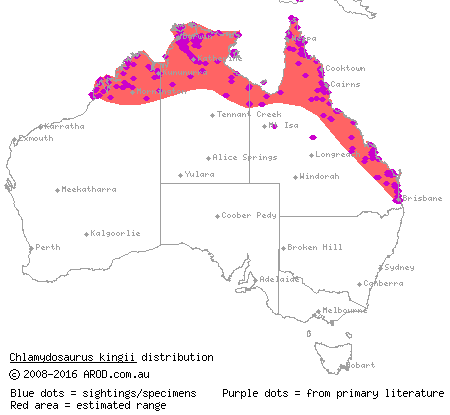Frilled Dragon
Frilled Dragon (Frilled Lizard, or Frilly)
Chlamydosaurus kingii

General Information
Family: Agamidae
Locale: Northern Australia, southern New Guinea
Habitat: Open bush land, open forests, grassland
Average Size: 28 cm SVL, 95 cm TL; males: 22-24” TL; females: 18-24” TL
Average Lifespan: 5-7 years or >10 years (depending on source)
Activity: Diurnal
Care Summary
Captive Care: These tree dwelling lizards need a tall cage to allow for climbing. Enclosure for a breeding pair should be around 130 x 100 x 220 cm with many large branches for climbing and perching. Juveniles up to 12 inches can be kept in 20 gal tall aquarium. Substrate: Course sand (~5cm) or bare bottom. Artificial plants are recommended as the animals will destroy live plants. Water: Mist the cage daily for adults, three times a day for hatchlings to prevent dehydration. Frillies will drink water droplets off surfaces. A water bowl should also be kept in the cage as the animals may learn to drink from standing water.
Diet: Insectivorous—hatchlings and adults will eat appropriately sized crickets, dubia roaches, mealworms, hornworms, or waxworms. Dust insects with a calcium, vitamin supplement (I use 4 parts Repcal: 1 part Herptivite); adults will also eat Zoophoba (superworms), pieces of meat (or pinky mice), but generally not plant material – will occasionally eat fruit. Frillies are “sit and wait” predators.
Temperature: 85-90°F with basking up to 115°F; up to 38°C (100°F) during the day, with a drop to around room temperature at night.
Lighting: Full spectrum with spot lights for heat.
Notes: The frilled lizard gets its name from the “ruff” that it erects around its head when threatened or startled. This is an extension of the hyoid bone. The hyoid skeleton is made of the bones and cartilage of the tongue, connected by muscles to the edges of the lower jaw and the breastbone in the rear. When startled, the frilled lizard will open its mouth, flex tongue muscles attached to the hyoid, and raise its frill. The frill is also displayed during mating. An additional interesting behavior is the bipedal locomotion found in adults as they chase prey on the ground.
References
Corning, S. (2016). Frilled Lizard Care Sheet. Received from http://www.reptilesmagazine.com/Care-Sheets/Frilled-Lizard-Care-Sheet/
Hauschild, A., Bosch, H. (2000). Bearded Dragons and Frilled Lizards. Matthias Schmidt Publications, Munster, Germany. 95pp.
Weiss, P. (2003). "Thrills, chills and Frills" Reptiles 11(4):48-63.
Range Map: http://www.arod.com.au/arod/reptilia/Squamata/Agamidae/Chlamydosaurus/kingii
Compiled by Eileen Underwood, 2004. Updated 8/2016.
Related Projects
by students in the BGSU Herpetarium
The Herpetarium is a facility in the Department of Biological Sciences.
Bowling Green State University | Bowling Green, OH 43403-0001 | Contact BGSU Herpetarium | Campus Map
Updated: 04/13/2021 02:19PM


